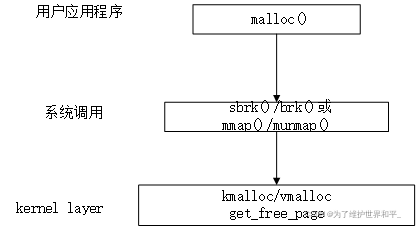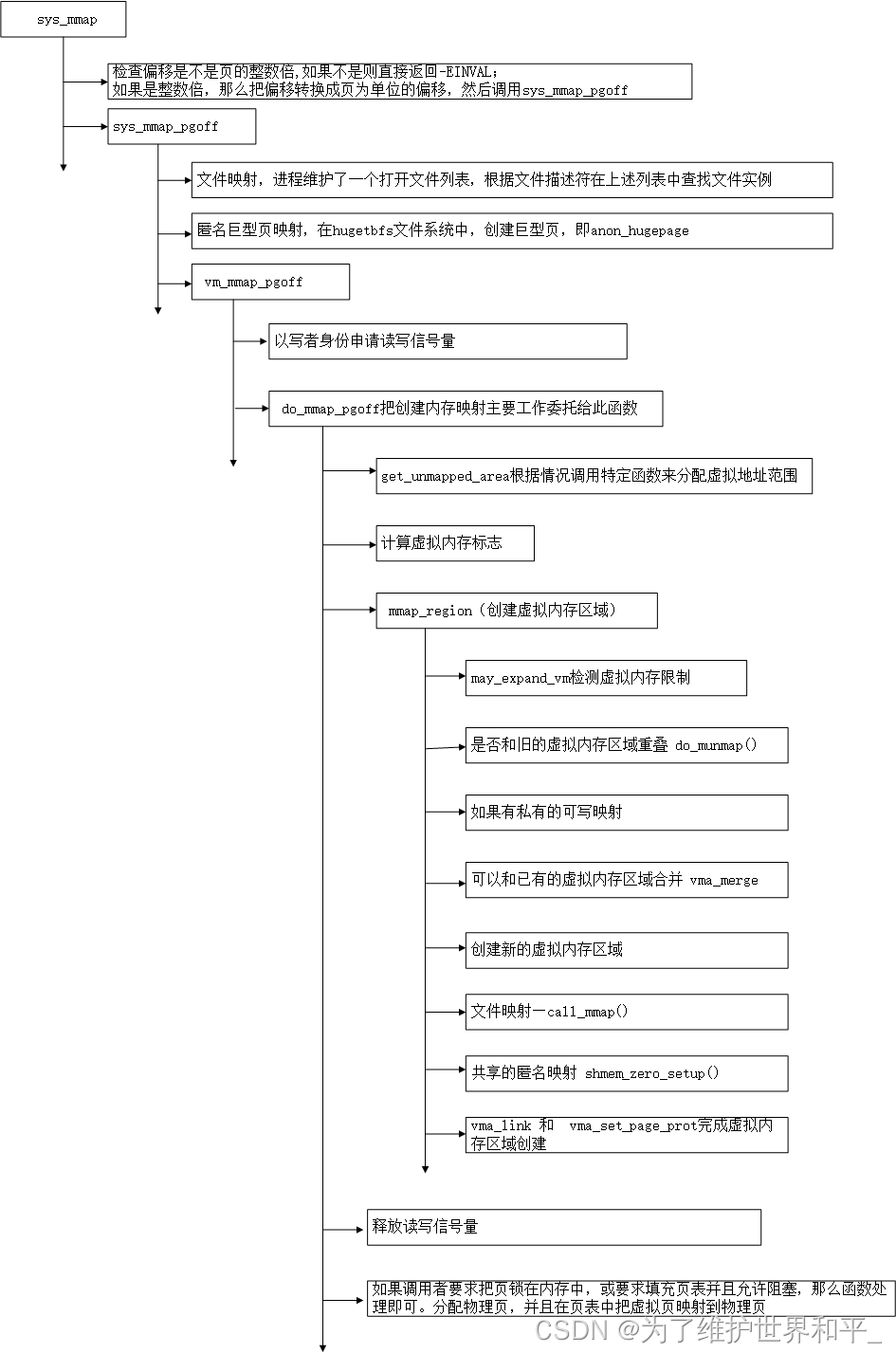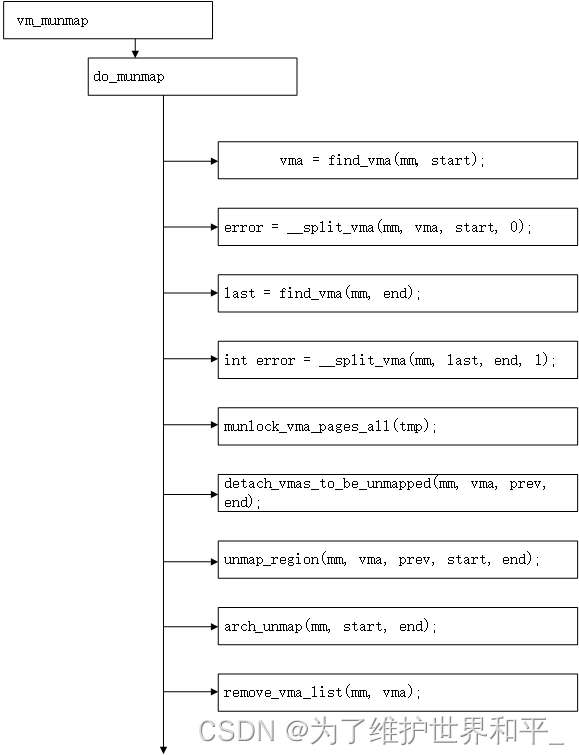linux内核源码分析之虚拟内存映射
目录
内存映射原理
系统调用
mmap内存映射原理三个阶段
sys_mmap系统调用
munmap系统调用
内存映射即在进程的虚拟内存地址空间中创建一个映射,分为两种
1)文件映射:文件支持的内存映射,把文件的一个区间映射到进程的虚拟地址空间,数据源是存储设备上的文件。
2)匿名映射:没有文件支持的内存映射,把物理内存映射到进程的虚拟地址空间,没有数据源。
内存映射原理
创建内存映射时,在进程的用户虚拟地址空间中分配一个虚拟内存区域。内核采用延迟分配物理内存的策略,在进程第一次访问虚拟页的时候,产生缺页异常。
- 如果是文件映射,那么分配物理页,把文件指定区间的数据读到物理页中,然后在页表中把虚拟页映射到物理页;
- 如果是匿名映射,就分配物理页,然后在页表中把虚拟页映射到物理页 ;
系统调用

应用程序 malloc或mmap申请内存,glibc库的内存分配器ptmalloc使用brk或mmap向内核以页为单位申请虚拟内存,然后把页划分成小内存块给应用程序。
默认阈值是128kb,如果应用程序申请的内存长度小于阈值,ptmalloc使用brk,否则使用mmap
注:应用层的mmap和内核中的mmap参数不一样
库函数
#include void* mmap(void* start,size_t length,int prot,int flags,int fd,off_t offset);内核
int mmap(struct file *filp, struct vm_area_struct *vma)mmap内存映射原理三个阶段
- 进程启动映射过程,并在虚拟地址空间中为映射创建虚拟映射区域;
- 调用内核空间的系统调用mmap,实现物理地址空间和进程的虚拟的一一映射关系;
- 进程发起对这片映射空间的访问,引发缺页异常,实现文件内容到物理内存的拷贝;
sys_mmap系统调用

mmap 创建 " 内存映射 " 的调用mmap 和 mmap2 ;
mmap 偏移单位是 " 字节 " ,mmap2 偏移单位是 " 页 " ,
在 arm 64 体系架构中 , 没有实现 mmap2 , 只实现了 mmap 系统调用 ;
munmap系统调用
系统调用munmap用来删除内存映射,它有两个参数:起始地址和长度即可。它的主要工作委托给内核源码文件处理mm/mmap.c

步骤解析
- vma = find_vma(mm,start);//根据起始地址找到要删除的第一个虚拟内存区域vma
- 如果只删除虚拟内存区域vam的部分,那么分裂虚拟内存区域vma
- 根据结束地址找到删除的最后一个虚拟内存区域vma
- 如果只删除虚拟内存区域last的一部分,那么分裂虚拟内存区域vma
- 针对所有删除目标,如果虚拟内存区域被锁定在内存中,调用函数解锁
- 把所有目标从进程虚拟内存区域链表和树链表中删除,组成一条临时链表
- 针对所有删除目标,在进程的页表中删除映射,并且从处理器的页缓存中删除映射
- 执行处理器架构特定的处理操作
- 删除所有目标
源码如下:
//找到要删除的 第一个 虚拟内存区域 vm_area_struct 结构体实例 int __do_munmap(struct mm_struct *mm, unsigned long start, size_t len,struct list_head *uf, bool downgrade){unsigned long end;struct vm_area_struct *vma, *prev, *last;if ((offset_in_page(start)) || start > TASK_SIZE || len > TASK_SIZE-start)return -EINVAL;len = PAGE_ALIGN(len);end = start + len;if (len == 0)return -EINVAL;/* * arch_unmap() might do unmaps itself. It must be called * and finish any rbtree manipulation before this code * runs and also starts to manipulate the rbtree. */// 该处理器架构 对应的 删除内存映射的处理操作arch_unmap(mm, start, end);/* Find the first overlapping VMA */vma = find_vma(mm, start);if (!vma)return 0;prev = vma->vm_prev;/* we have start vm_end *//* if it doesn't overlap, we have nothing.. */if (vma->vm_start >= end)return 0;/* * If we need to split any vma, do it now to save pain later. * * Note: mremap's move_vma VM_ACCOUNT handling assumes a partially * unmapped vm_area_struct will remain in use: so lower split_vma * places tmp vma above, and higher split_vma places tmp vma below. */if (start > vma->vm_start) {int error;/* * Make sure that map_count on return from munmap() will * not exceed its limit; but let map_count go just above * its limit temporarily, to help free resources as expected. */if (end vm_end && mm->map_count >= sysctl_max_map_count)return -ENOMEM; //不是删除整个 vam 内存区域,指向分裂的区域error = __split_vma(mm, vma, start, 0);if (error)return error;prev = vma;}/* Does it split the last one? */last = find_vma(mm, end);if (last && end > last->vm_start) {int error = __split_vma(mm, last, end, 1);if (error)return error;}vma = prev ? prev->vm_next : mm->mmap;if (unlikely(uf)) {/* * If userfaultfd_unmap_prep returns an error the vmas * will remain splitted, but userland will get a * highly unexpected error anyway. This is no * different than the case where the first of the two * __split_vma fails, but we don't undo the first * split, despite we could. This is unlikely enough * failure that it's not worth optimizing it for. */int error = userfaultfd_unmap_prep(vma, start, end, uf);if (error)return error;}/* * unlock any mlock()ed ranges before detaching vmas *///解锁if (mm->locked_vm) {struct vm_area_struct *tmp = vma;while (tmp && tmp->vm_start vm_flags & VM_LOCKED) {mm->locked_vm -= vma_pages(tmp);munlock_vma_pages_all(tmp);}tmp = tmp->vm_next;}}/* Detach vmas from rbtree */// 虚拟内存区域 " 从 进程的 虚拟内存区域 链表 和 红黑树 数据结构中删除detach_vmas_to_be_unmapped(mm, vma, prev, end);if (downgrade)downgrade_write(&mm->mmap_sem);//被删除内存区域 对应的 映射 " 删除 , 从处理器页表缓存中也删除对应映射unmap_region(mm, vma, prev, start, end);/* Fix up all other VM information *///删除所有的虚拟内存区域remove_vma_list(mm, vma);return downgrade ? 1 : 0;}int do_munmap(struct mm_struct *mm, unsigned long start, size_t len, struct list_head *uf){return __do_munmap(mm, start, len, uf, false);}int vm_munmap(unsigned long addr, size_t len){struct mm_struct *mm = current->mm;int ret;down_write(&mm->mmap_sem);ret = do_munmap(mm, addr, len, NULL);up_write(&mm->mmap_sem);return ret;}

